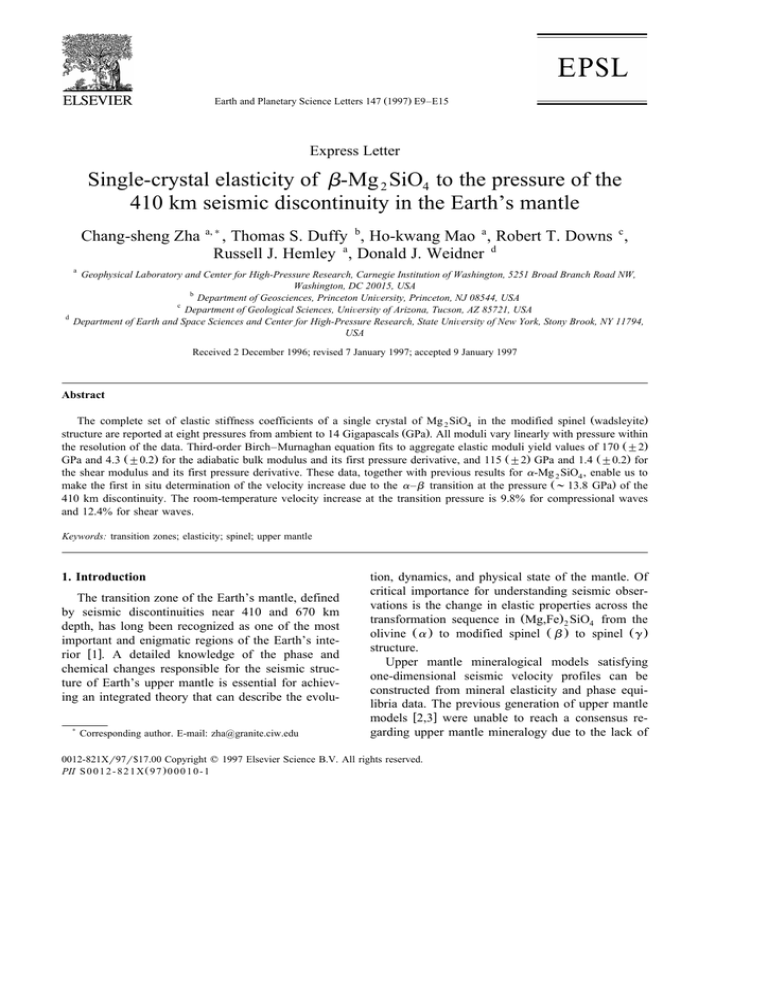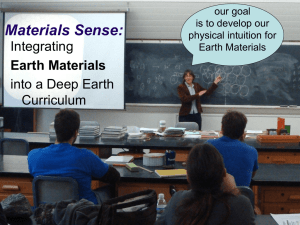
Earth and Planetary Science Letters 147 Ž1997. E9–E15
Express Letter
Single-crystal elasticity of b-Mg 2 SiO4 to the pressure of the
410 km seismic discontinuity in the Earth’s mantle
Chang-sheng Zha
a,)
, Thomas S. Duffy b, Ho-kwang Mao a , Robert T. Downs c ,
Russell J. Hemley a , Donald J. Weidner d
a
d
Geophysical Laboratory and Center for High-Pressure Research, Carnegie Institution of Washington, 5251 Broad Branch Road NW,
Washington, DC 20015, USA
b
Department of Geosciences, Princeton UniÕersity, Princeton, NJ 08544, USA
c
Department of Geological Sciences, UniÕersity of Arizona, Tucson, AZ 85721, USA
Department of Earth and Space Sciences and Center for High-Pressure Research, State UniÕersity of New York, Stony Brook, NY 11794,
USA
Received 2 December 1996; revised 7 January 1997; accepted 9 January 1997
Abstract
The complete set of elastic stiffness coefficients of a single crystal of Mg 2 SiO4 in the modified spinel Žwadsleyite.
structure are reported at eight pressures from ambient to 14 Gigapascals ŽGPa.. All moduli vary linearly with pressure within
the resolution of the data. Third-order Birch–Murnaghan equation fits to aggregate elastic moduli yield values of 170 Ž"2.
GPa and 4.3 Ž"0.2. for the adiabatic bulk modulus and its first pressure derivative, and 115 Ž"2. GPa and 1.4 Ž"0.2. for
the shear modulus and its first pressure derivative. These data, together with previous results for a-Mg 2 SiO4 , enable us to
make the first in situ determination of the velocity increase due to the a – b transition at the pressure Ž; 13.8 GPa. of the
410 km discontinuity. The room-temperature velocity increase at the transition pressure is 9.8% for compressional waves
and 12.4% for shear waves.
Keywords: transition zones; elasticity; spinel; upper mantle
1. Introduction
The transition zone of the Earth’s mantle, defined
by seismic discontinuities near 410 and 670 km
depth, has long been recognized as one of the most
important and enigmatic regions of the Earth’s interior w1x. A detailed knowledge of the phase and
chemical changes responsible for the seismic structure of Earth’s upper mantle is essential for achieving an integrated theory that can describe the evolu)
Corresponding author. E-mail: zha@granite.ciw.edu
tion, dynamics, and physical state of the mantle. Of
critical importance for understanding seismic observations is the change in elastic properties across the
transformation sequence in ŽMg,Fe. 2 SiO4 from the
olivine Ž a . to modified spinel Ž b . to spinel Žg .
structure.
Upper mantle mineralogical models satisfying
one-dimensional seismic velocity profiles can be
constructed from mineral elasticity and phase equilibria data. The previous generation of upper mantle
models w2,3x were unable to reach a consensus regarding upper mantle mineralogy due to the lack of
0012-821Xr97r$17.00 Copyright q 1997 Elsevier Science B.V. All rights reserved.
PII S 0 0 1 2 - 8 2 1 X Ž 9 7 . 0 0 0 1 0 - 1
E10
C.-s. Zha et al.r Earth and Planetary Science Letters 147 (1997) E9–E15
direct elasticity measurements at high pressure and
temperature. This has motivated considerable efforts
to extend mineral sound velocity measurements to
higher pressures w4–10x. While the single-crystal
elastic properties of the olivine phase are now reasonably well characterized at high pressure w5,7–9x,
there have previously been no such measurements
for the high-pressure polymorphs.
2. Experimental method
Single-crystal samples of b-Mg 2 SiO4 were synthesized in a large volume press at 18.8 GPa and
15008C. Two high quality samples were selected and
polished to flat, parallel plates with thicknesses of 30
and 50 mm. Each was polished within a few degrees
of the crystallographic plane which intersects the
three crystal axes at equal angles. Electron microprobe analysis demonstrated that the samples were
pure Mg 2 SiO4 . Electron microscopy showed that
submicron inclusions are present in restricted areas
for both samples. Raman spectroscopy revealed no
peaks that could be attributed to hydroxyl. Singlecrystal X-ray diffraction was performed at ambient
and at selected elevated pressures Ž1.8 GPa, 3.2 GPa
and 10.2 GPa.. The ambient pressure volume was
˚ 3, consistent with a previous determi535.8 Ž"0.2. A
nation w11x. High-pressure volumes also agree with
the earlier data, as well as with the equation of state
from Brillouin scattering determined here.
Acoustic velocities were measured using Brillouin
scattering in a diamond anvil cell. There are a number of potential problems that can arise when making
such measurements, including restricted optical access and overlap of Brillouin peaks from the pressure
medium and the sample. We have recently succeeded
in developing techniques that overcome these problems and allow for determination of the complete set
of elastic stiffness coefficients at high pressures for
materials of orthorhombic and hexagonal symmetries
w6–8x. However, when examining materials with high
acoustic velocities, such as high-pressure polymorphs, compressional Brillouin peaks from the
sample fall within the same spectral region as the
shear peaks from the diamond anvils. Since the
volume of diamond is much larger than the volume
of sample material, the diamond Brillouin peaks
completely obscure the sample peaks. Since the two
diamonds will also, in general, have different crystal
orientations, each will contribute its own Brillouin
peaks and a large spectral region can be affected. For
b-Mg 2 SiO4 , the compressional wave velocities of
the sample were obscured by the diamond shear
wave peaks at pressures above 10 GPa. To overcome
this problem, a long focal length cylindrical lens
together with a spatial filter were used to reduce the
astigmatism introduced by the anvils. This method
was found to reduce the intensity of the diamond
signal by more than 90% for a 30 mm thick sample
ŽFig. 1.. The astigmatism correction also markedly
reduces the size of the peaks from the pressure
medium. While it was not possible to remove the
diamond signal completely, it was sufficiently de-
Fig. 1. Comparison of Brillouin spectra of wadsleyite at 10.5 GPa
before Župper panel. and after Žlower panel. astigmatism correction. Peaks: R s unshifted Rayleigh peaks; P and S s
compressional and shear peaks in b-Mg 2 SiO4 , respectively; ME
s peaks from the methanol–ethanol pressure medium; Ds peaks
from the diamond anvils. Similar data collection times were used
in obtaining both spectra.
C.-s. Zha et al.r Earth and Planetary Science Letters 147 (1997) E9–E15
E11
pressed that the sample compressional wave signal
could be readily observed.
The 50 mm thick sample was loaded into a diamond anvil cell together with an argon pressure
transmitting medium and a grain of ruby for pressure
calibration. Brillouin spectra were recorded at 3.1,
6.3, 8.1, and 9.4 GPa. After pressure release, the
sample was recovered and Brillouin spectra were
measured at ambient pressure. The 30 mm thick
sample was loaded in a separate diamond cell with a
4:1 methanol–ethanol mixture as a pressure medium.
Brillouin spectra were recorded at 10.1 and 10.5
GPa. This sample was then unloaded, recovered, and
reloaded using a helium pressure medium. Brillouin
spectra were recorded at 14.2 GPa. However, premature failure of the diamond anvils resulted in loss of
this sample during pressure release from 14.2 GPa.
3. Results
At each pressure, the compressional and two shear
acoustic velocities were determined at about 18 directions at 108 intervals within the plane perpendicular to the diamond cell axis. A total of 400 acoustic
velocities, representing more than 400 h of total data
collection time, were recorded in this study. The data
were inverted using non-linear least-squares to obtain the nine independent elastic moduli as a function
of pressure ŽFig. 2, Table 1.. Previous ambient pressure data w12x are also shown in the figure; this is the
first determination of individual elastic moduli at
high pressure for this material. All elastic moduli
vary linearly with pressure within the resolution of
the data.
Bounds on the bulk and shear moduli of a randomly oriented polycrystalline aggregate of bMg 2 SiO4 were obtained from the single-crystal moduli using Voigt–Reuss–Hill averages w13x ŽFig. 3..
The Voigt and Reuss limits differ by 0.3–0.9% for
the bulk modulus and by 1.2–2.8% for the shear
modulus. Fitting the data to the Birch–Murnaghan
equation yields a value of 170 Ž"2. GPa for the
bulk modulus, K 0S , and 4.3 Ž"0.2. for its pressure
derivative, KX0S . Values of 115 Ž"2. GPa and 1.4
Ž"0.2. are obtained for the shear modulus, G0 , and
its pressure derivative, G0X . For the ambient pressure
moduli, these values are in reasonable agreement
with previous single-crystal elasticity data w12x for
Fig. 2. Single-crystal elastic moduli of wadsleyite as a function of
pressure. Filled symbols are the present data with 2 s uncertainties. The solid lines are linear fits to the data. A single line is used
to fit the data for C 11 and C 22 . Previous ambient pressure data
w12x are shown as open symbols.
this phase ŽK 0S s 174 GPa, G0 s 114 GPa.. Aggregate sound velocity measurements were previously
reported for a slightly porous, polycrystalline aggregate of b-Mg 2 SiO4 to 3 GPa using ultrasonic techniques w9x. The pressure derivatives obtained in that
study wKX0 s 4.8 Ž"0.1. and G0X s 1.8 Ž"0.1.x are
higher than those found here. More recently, these
measurements were extended to 12 GPa using a
large-volume press w10x. When fit in the same manner as our data Ži.e., to third-order finite strain
equations., the pressure derivatives ŽKX0 s 4.5, G0X s
C.-s. Zha et al.r Earth and Planetary Science Letters 147 (1997) E9–E15
E12
Table 1
Elastic moduli of b-Mg 2 SiO4
P
C 11
C 22
C 33
C 44
C 55
C 66
C 12
C 13
C 23
0
370.5
7.8
379.3
11.5
393.4
7.9
404.2
11.2
414.4
11.2
428.8
11.3
421.9
6.7
444.5
15.9
367.7
6.5
382.0
10.4
399.9
12.3
418.3
16.8
439.8
13.0
416.0
9.9
425.7
14.2
464.9
16.1
272.4
5.8
292.2
4.5
316.7
6.1
324.0
5.4
333.1
5.8
333.9
7.9
330.7
7.7
386.8
11.3
111.2
3.6
111.2
2.2
126.6
3.7
121.4
6.4
127.1
5.3
117.6
2.2
121.7
6.8
130.9
3.7
122.5
4.0
122.7
1.8
117.5
2.6
123.6
6.7
122.8
3.8
128.2
3.0
127.2
4.3
121.7
2.8
103.1
3.9
100.7
6.1
117.0
5.8
118.5
7.0
118.4
6.4
121.1
2.4
116.2
3.3
129.7
3.3
65.6
4.5
85.4
6.6
83.9
6.1
94.4
6.8
103.9
5.9
104.5
4.1
107.8
4.4
123.9
4.6
95.2
5.2
105.5
5.4
118.2
4.6
122.3
5.5
123.8
6.8
130.2
6.9
127.9
5.4
142.0
12.2
105.1
4.4
112.4
5.3
119.1
5.0
123.4
6.7
131.8
5.9
110.8
5.8
125.4
6.0
151.9
19.6
3.1
6.3
8.1
9.4
10.1
10.5
14.2
All quantities are in GPa. Uncertainties Ž2 s . are listed below each value.
1.6. are intermediate between our results and the
previous ultrasonic studies. The use of polycrystalline samples, which retain some porosity even at
the highest pressures, may be responsible for these
differences.
4. Discussion
One of the advantages of single-crystal elasticity
measurements is that they define the complete velocity surface at high pressure. This is particularly
Fig. 3. Bulk ŽKS. and Shear ŽG. moduli of wadsleyite and forsterite w7,8x as a function of pressure. Symbols are Voigt–Reuss–Hill averages
and solid lines are third-order finite strain fits to the data. Uncertainties in the VRH averages are approximately the size of the symbols.
C.-s. Zha et al.r Earth and Planetary Science Letters 147 (1997) E9–E15
E13
Fig. 4. Sound velocity distributions in the a and b forms of Mg 2 SiO4 at 13.8 GPa. The data are shown for the three principal planes, ab,
bc, and ca. Forsterite data are from w7,8x. Linear least-squares fits to the individual moduli Že.g., Fig. 2. were used to compute the moduli at
13.8 GPa.
important for understanding the seismic anisotropy
of the Earth’s upper mantle w14–16x. Fig. 4 shows a
comparison of the velocity distributions in the principal planes for a- and b-Mg 2 SiO4 at 13.8 GPa,
approximately the pressure of the 410 km discontinuity in the mantle. Near the a direction and throughout most of the a–c plane, compressional sound
velocities in forsterite and wadsleyite are similar. For
Fig. 5. Aggregate compressional and shear wave velocities of wadsleyite and forsterite from single-crystal Brillouin scattering measurements
w7,8x as a function of pressure and depth. ` and v s experimental data. Solid lines are calculated using the third-order Eulerian finite strain
equations. The vertical dashed line corresponds to the 410 km discontinuity.
E14
C.-s. Zha et al.r Earth and Planetary Science Letters 147 (1997) E9–E15
compressional velocities, the major difference between the two phases is along the b direction. This is
the minimum velocity direction in forsterite, but the
maximum velocity direction in b-Mg 2 SiO4 . Within
the principal planes, neither form of the material
exhibits a large amount of anisotropy for shear velocities. The velocity anisotropy is a weakly decreasing function of pressure. The compressional velocity
anisotropy for b-Mg 2 SiO4 is 17% at ambient pressure, but is in the range of 10–14% at pressures
between 10 and 14 GPa. Similarly, the maximum
shear wave birefringence is 18% at ambient pressure,
but is found to be 13–14% at the highest pressures.
The present results, together with previously reported data for forsterite to 16 GPa w7,8x, allow us to
make the first direct determination of the velocity
difference between the a and b phases of Mg 2 SiO4
at the pressure of the 410 km discontinuity. Compressional and shear velocities for randomly oriented
polycrystalline aggregates for both phases are shown
in Fig. 5. At ambient pressure, the velocity contrast
between the two phases is 12.3% for compressional
waves and 14.2% for shear waves. At 13.8 GPa,
these differences have been reduced to 9.8% for
compressional waves and 12.4% for shear waves.
Typical seismic velocity contrasts across the 410 km
discontinuity are in the range of 4–5% w17–19x.
These are 31–51% of the value of the room-temperature a – b velocity jump at this depth. In an earlier
analysis w7x, which used extrapolated low-pressure
data w4x to characterize the elasticity of b-Mg 2 SiO4 ,
it was concluded that, based on the magnitude of the
410 km discontinuity, the olivine faction of the
mantle at this depth is less than 40%. When the
present results for wadsleyite are substituted into this
analysis, the maximum allowable olivine fraction of
the mantle increases to 50% by volume w20x. Future
refinement of these values can be obtained from
measurements of the effect of temperature on the
velocity contrast across the discontinuity.
Acknowledgements
This research was supported by the NSF. The
Center for High-Pressure Research is an NSF Science and Technology Center. [FA]
References
w1x F. Birch, Elasticity and constitution of the Earth’s Interior, J.
Geophys. Res. 57, 227–286, 1952.
w2x T.S. Duffy and D.L. Anderson, Seismic velocities in mantle
minerals and the mineralogy of the upper mantle, J. Geophys.
Res. 94, 1895–1912, 1989.
w3x D.J. Weidner and E. Ito, Mineral physics constraints on a
uniform mantle composition, in: High-Pressure Research in
Mineral Physics, M.H. Manghnani and Y. Syono, eds., pp.
439–446, Terrapub, Tokyo, 1987.
w4x G.D. Gwanmesia, S. Rigden, I. Jackson and R.C. Liebermann, Pressure dependence of elastic wave velocity for
b-Mg 2 SiO4 , and the composition of the Earth’s mantle,
Science 250, 794–797, 1990.
w5x J.M. Zaug, E.H. Abramson, J.M. Brown and L.J. Slutsky,
Sound velocities in olivine at earth mantle pressures, Science
260, 1487–1489, 1993.
w6x C.S. Zha, T.S. Duffy, H.K. Mao and R.J. Hemley, Elasticity
of hydrogen to 24 GPa from single-crystal Brillouin scattering and synchrotron x-ray diffraction, Phys. Rev. B 48,
9246–9255, 1993.
w7x T.S. Duffy, C.S. Zha, R.T. Downs, H.K. Mao and R.J.
Hemley, Elasticity of forsterite to 16 GPa and the composition of the upper mantle, Nature 378, 170–173, 1995.
w8x C.S. Zha, T.S. Duffy, R.T. Downs, H.K. Mao and R.J.
Hemley, Sound velocity and elasticity of single-crystal
forsterite to 16 GPa, J. Geophys. Res. 101, 17,535–17,545,
1996.
w9x G. Chen, B. Li and R.C. Liebermann, Selected elastic moduli
of single-crystal olivines from ultrasonic experiments to mantle pressures, Science 272, 979–980, 1996.
w10x B. Li, G.D. Gwanmesia and R.C. Liebermann, Sound velocities of olivine and beta polymorphs of Mg 2 SiO4 at Earth’s
transition zone pressures, Geophys. Res. Lett. 23, 2259–2262,
1996.
w11x R.M. Hazen, J. Zhang and J. Ko, Effects of FerMg on the
compressibility of synthetic wadsleyite: b-ŽMg 1y x Fe x . 2 SiO4
Žx F 0.25., Phys. Chem. Mineral. 17, 416–419, 1990.
w12x H. Sawamoto, D.J. Weidner, S. Sasaki and M. Kumazawa,
Single-crystal elastic properties of the modified spinel Žbeta.
phase of magnesium orthosilicate, Science 224, 749–751,
1984.
w13x J.P. Watt and L. Peselnick, Clarification of the Hashin–
Shtrikman bounds on the effective elastic moduli of polycrystals with hexagonal, trigonal, and tetragonal symmetries,
J. Appl. Phys. 51, 1525–1531, 1980.
w14x P. Silver and W.W. Chan, Implications for continental structure and evolution from seismic anisotropy, Nature 335,
34–39, 1988.
w15x T. Tanimoto and D.L. Anderson, Mapping convection in the
mantle, Geophys. Res. Lett. 11, 287–290, 1984.
w16x S.J. Kaneshima, Seismic anisotropy: A review of studies by
Japanese researchers, J. Phys. Earth 43, 301–320, 1995.
w17x G. Nolet, S.P. Grand and B.L.N. Kennett, Seismic heterogeneity in the upper mantle, J. Geophys. Res. 99, 23,753–
23,766, 1994.
C.-s. Zha et al.r Earth and Planetary Science Letters 147 (1997) E9–E15
w18x S.P. Grand and D.V. Helmberger, Upper mantle shear structure of North America, Geophys. J.R. Astron. Soc. 76,
399–438, 1984.
w19x J. Mechie, A.V. Egorkin, K. Fuchs, T. Ryberg, L. Solodilov
and F. Wenzel, P-wave mantle velocity structure beneath
northern Eurasia from long-range recordings along the profile Quartz, Phys. Earth Planet. Inter. 79, 269–286, 1993.
E15
w20x C.S. Zha, T.S. Duffy, R.T. Downs, H.K. Mao, R.J. Hemley
and D.J. Weidner, Single-crystal elasticity of the a and b
polymorphs of Mg 2 SiO4 at high pressure, in: High-Pressure
Temperature Research: Properties of Earth and Planetary
Materials, M.H. Manghnani and T. Yagi, eds., in press, 1997.






